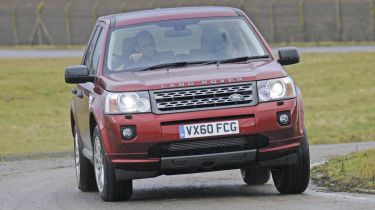Land Rover Freelander 2 ed4
Front-wheel drive marks a new dawn for British firm
When Land Rover launched its first Freelander in 1997, the car quickly became the best-selling 4x4 in Europe – a position it held for five years. Now, bosses are offering the popular model with a 2WD drivetrain for the first time, in a bid to attract environmentally conscious buyers to the marque.
One thing that hasn’t changed is the car’s unmistakable shape. The subtle step in the roofline where the bodywork rises just behind the rear doors, its clamshell bonnet, chunky wheelarches and imposing grille are all Land Rover trademarks. Contemporary details include vents behind the front wheels, LED daytime running lights and blacked-out D-pillars, the latter creating the illusion of a wraparound rear screen.
Video: watch CarBuyer's video review of the Freelander
[[{"type":"media","view_mode":"content_narrow","fid":"68635","attributes":{"alt":"","class":"media-image"}}]]
Parked next to its rivals, you instantly notice the size of the Freelander 2 – it’s bigger in every dimension than the Kia and sits nearly 200mm higher than the BMW. Next to the X1, you’d swear the Tonka toy-styled Land Rover was from a different class.
The size differences are even more obvious on the inside, as its cabin feels by far the biggest here. Our test car’s optional light leather upholstery played its part, but the high roofline and large glass area all contribute to the airy feeling of the interior.
Used - available now

2023 Land Rover
Defender 90
8,047 milesAutomaticDiesel3.0L
Cash £61,960
2023 Mercedes
GLA
28,116 milesAutomaticDiesel2.0L
Cash £28,760
2022 BMW
X1
33,509 milesAutomaticPetrol2.0L
Cash £23,700
2022 BMW
3 Series
48,218 milesAutomaticDiesel3.0L
Cash £28,500The high driving position – which also feels considerably taller than in the other models – and low dashboard design mean you have a much more commanding view than in either the Kia or BMW. But from behind the wheel, the Freelander isn’t as car-like, and although the seats prove comfortable over long journeys, they lack side support when cornering. Plus, many of the controls are out of reach, and you have to stretch out to adjust the climate settings.
When you do, you’ll notice some of the plastics are of a low quality and that the simple instruments are unexciting to look at. Passengers travelling in the back won’t care, however. There’s plenty of rear space, and the boot is the largest on test. On the road, there’s no disguising the Freelander’s off-tarmac heritage, as its drive is the least engaging in this company.
There’s plenty of grip from the front-wheel-drive chassis but there’s a lot of body roll, too. Turn into a bend, and you have to wait a moment for the car to settle on its springs. Once you get used
to this comfort-oriented set-up, it’s fine, yet after driving the BMW or smaller Kia, it comes as something of a shock.
Body movement is pronounced under acceleration and braking as well, because the nose pitches and dives as you accelerate and brake. This didn’t seem to affect outright performance, though,
as the Land Rover recorded the shortest stopping distances during our tests.
The engine is the star of the show. A peak torque figure of 420Nm is 100Nm up on the BMW and 160Nm more than the Kia, and the 2.2-litre diesel is punchy. However, the slow- witted gearbox doesn’t encourage quick shifts, and the Freelander’s size and soft suspension mean it feels rather unwieldy both on narrow lanes and around town.
Compared to the sharp X1 and light-on-its-feet Sportage, the Land Rover is imprecise and detached from the action. Yet if the tall body height and soft springs hamper the Freelander on tarmac, they come into their own in the mud. Despite its new 2WD set-up, the car was the most capable and confidence-inspiring choice on muddy tracks. But that’s not the main focus of this test
– if you want a genuine off-roader, you’ll buy the 4x4.
No, the newcomer’s green credentials are just as important here – and unfortunately, this is where the Land Rover falls further behind. With combined economy of 47.2mpg, the British machine has the lowest official figure of our trio – the X1 should manage another 7mpg – and our actual result of 31.2mpg disappointed. This was despite the fact that the Freelander is equipped with a stop-start system, which, unlike the X1’s, continued to operate in the near-freezing temperatures on our test.
Tailpipe emissions of 158g/km are also off the pace. The 2WD Freelander is only 7g/km cleaner than the 4WD version, and trails its closest rival here by more than 15g/km, so there’s little to be gained by taking the eco route from this point of view. What the newcomer does do, however, is bring the Freelander within range of a wider audience than before – entry-level S models
start from only £21,995.
Whether or not this will be enough to win a test against a pair of purpose-designed crossover models will soon be revealed...
Details
Chart position: 2
WHY: Brand has peerless image, while tweaks mean this is its most efficient car yet. Despite the 2WD chassis, it offers the most ground clearance and off-road ability here.







